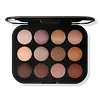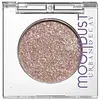What's inside
What's inside
 Key Ingredients
Key Ingredients

 Benefits
Benefits

 Concerns
Concerns

No concerns
 Ingredients Side-by-side
Ingredients Side-by-side

Lauroyl Lysine
Skin ConditioningHdi/Trimethylol Hexyllactone Crosspolymer
Magnesium Myristate
Polymethyl Methacrylate
Silica
AbrasiveButylene Glycol
HumectantCaprylyl Glycol
EmollientCaprylic/Capric Triglyceride
MaskingPolyglyceryl-3 Polyricinoleate
EmulsifyingPvp
Emulsion StabilisingPolyhydroxystearic Acid
EmulsifyingHexylene Glycol
EmulsifyingIsostearic Acid
CleansingLecithin
EmollientPhenoxyethanol
PreservativeMica
Cosmetic ColorantCI 77891
Cosmetic ColorantCI 77491
Cosmetic ColorantCI 77492
Cosmetic ColorantCI 77499
Cosmetic ColorantCI 77000
Cosmetic ColorantCI 77163
Cosmetic ColorantCI 42090
Cosmetic ColorantCI 77400
Cosmetic ColorantCI 75470
Cosmetic ColorantCI 77289
Cosmetic ColorantCI 77288
Cosmetic ColorantCI 77510
Cosmetic ColorantCI 61570
Cosmetic ColorantCI 77742
Cosmetic ColorantCI 77007
Cosmetic ColorantCI 19140
Cosmetic ColorantCI 15985
Cosmetic ColorantNylon-12
Octyldodecyl Stearoyl Stearate
EmollientIsostearyl Neopentanoate
EmollientSynthetic Fluorphlogopite
Tin Oxide
AbrasiveTocopheryl Acetate
AntioxidantAluminum Calcium Sodium Silicate
Calcium Aluminum Borosilicate
Calcium Sodium Borosilicate
Hydrogenated Polyisobutene
EmollientLauroyl Lysine, Hdi/Trimethylol Hexyllactone Crosspolymer, Magnesium Myristate, Polymethyl Methacrylate, Silica, Butylene Glycol, Caprylyl Glycol, Caprylic/Capric Triglyceride, Polyglyceryl-3 Polyricinoleate, Pvp, Polyhydroxystearic Acid, Hexylene Glycol, Isostearic Acid, Lecithin, Phenoxyethanol, Mica, CI 77891, CI 77491, CI 77492, CI 77499, CI 77000, CI 77163, CI 42090, CI 77400, CI 75470, CI 77289, CI 77288, CI 77510, CI 61570, CI 77742, CI 77007, CI 19140, CI 15985, Nylon-12, Octyldodecyl Stearoyl Stearate, Isostearyl Neopentanoate, Synthetic Fluorphlogopite, Tin Oxide, Tocopheryl Acetate, Aluminum Calcium Sodium Silicate, Calcium Aluminum Borosilicate, Calcium Sodium Borosilicate, Hydrogenated Polyisobutene
 Reviews
Reviews

Ingredients Explained
These ingredients are found in both products.
Ingredients higher up in an ingredient list are typically present in a larger amount.
Calcium Sodium Borosilicate is a bulking agent. It is considered a borosilicate glass; it is composed of powder or flakes of calcium and sodium borosilicates.
This ingredient is used to add volume, shine, and color to products. You'll most likely find this ingredient in makeup products.
According to in-vivo and ex-vivo studies done by a manufacturer, this ingredient works well with UV filters:
Learn more about Calcium Sodium BorosilicateCaprylyl Glycol is a humectant and emollient, meaning it attracts and preserves moisture.
It is a common ingredient in many products, especially those designed to hydrate skin. The primary benefits are retaining moisture, skin softening, and promoting a healthy skin barrier.
Though Caprylyl Glycol is an alcohol derived from fatty acids, it is not the kind that can dry out skin.
This ingredient is also used as a preservative to extend the life of products. It has slight antimicrobial properties.
Learn more about Caprylyl GlycolCi 77491 is also hydrated iron III oxide. It's sole purpose is to give a red/pink hue to products.
Iron III oxides are classified as inorganic chemicals for coloring.
Synthetically created Ci 77491 is considered safer than those naturally found. This is because the synthetically created version may contain less impurities. Iron oxides are generally non-toxic and non-allergenic.
Learn more about CI 77491Ci 77492 is also hydrated iron III oxide. It's sole purpose is to give a yellow hue to products.
Iron III oxides are classified as inorganic chemicals for coloring.
Synthetically created Ci 77492 is considered safer than those naturally found. This is because the synthetically created version may contain less impurities. Iron oxides are generally non-toxic and non-allergenic.
Learn more about CI 77492Ci 77499 is also hydrated iron III oxide. It is created from mixing red and black iron oxides. This helps give shades of darkness to a product.
Iron III oxides are classified as inorganic chemicals for coloring.
This ingredient is used to add a violet color to cosmetics.
It is created by reacting phosphoric acid, ammonium dihydrogen orthophosphate, and manganese dioxide.
Ci 77891 is a white pigment from Titanium dioxide. It is naturally found in minerals such as rutile and ilmenite.
It's main function is to add a white color to cosmetics. It can also be mixed with other colors to create different shades.
Ci 77891 is commonly found in sunscreens due to its ability to block UV rays.
Learn more about CI 77891Phenoxyethanol is a preservative that has germicide, antimicrobial, and aromatic properties. Studies show that phenoxyethanol can prevent microbial growth. By itself, it has a scent that is similar to that of a rose.
It's often used in formulations along with Caprylyl Glycol to preserve the shelf life of products.
Tin Oxide is an inorganic oxide used to add opacity and volume to a product. In nature, it is already found in mineral form. The main ore of tin is an opaque and shiny mineral called casseterite.
Tin Oxide helps remove translucency in a product, or make it more opaque. Besides adding opacity, tin oxide is used for bulking to add volume.